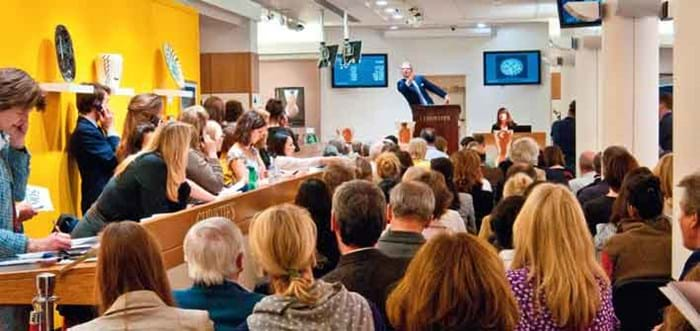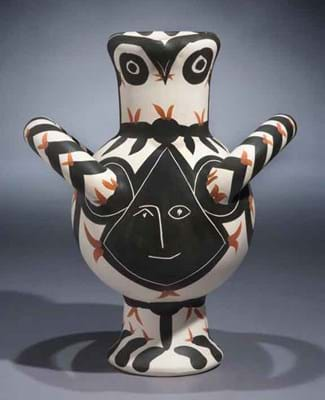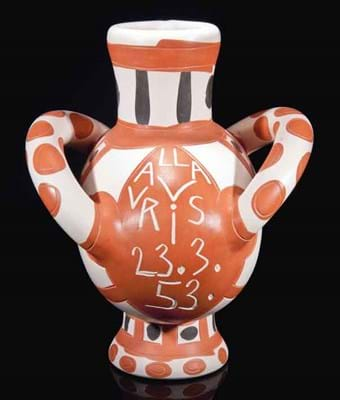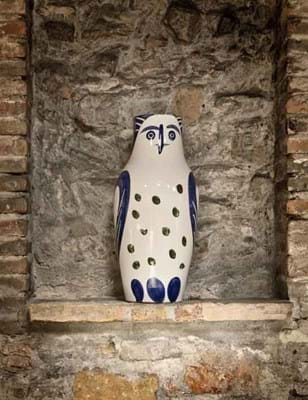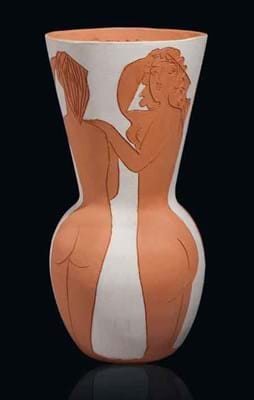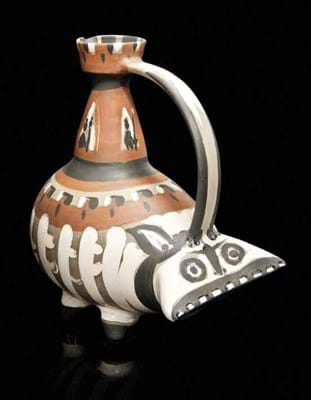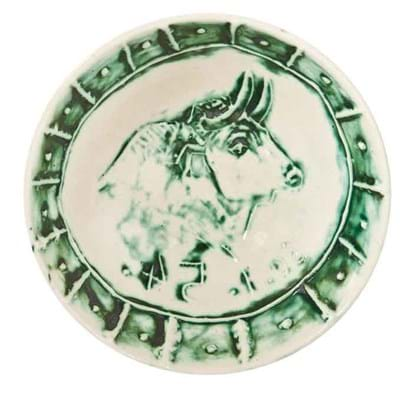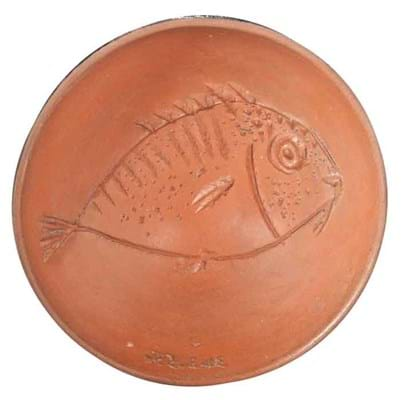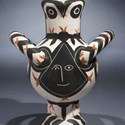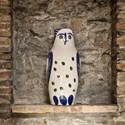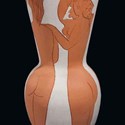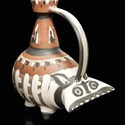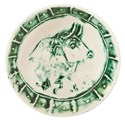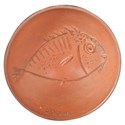Many of the pieces had remained untouched for decades at the Madoura Pottery studio in Vallauris in the South of France where Picasso had created them some 50 years ago. The collection, comprising only his editioned ceramics, was being sold by Alan Ramié, the author of the definitive catalogue raisonné of Picasso ceramic editions, and the son of the owners of the Madoura Pottery.
During Picasso's time there, from the mid 1940s to the start of the 1970s, he created more than 4000 vases, plates, pitchers and other forms, hundreds of which were turned into editioned pieces.
Christie's specialist India Phillips said: "This was a democratisation of his artwork, a more affordable and accessible medium for people who would have been able to purchase an editioned piece back in the 1960s and 1970s for only £30 or £40."
Editioned Picasso ceramics were made in multiples of 25 to 500, and the more limited the edition, the more desirable and expensive the piece. Condition and subject matter also greatly affect prices. Pieces in mint condition and decorated with images typically associated with Picasso, such as a bull, fish or bird, tend to prove more popular with collectors.
It took the auction house a week to wrap and remove the collection from the studio, which also included posters, photographs, books and furniture. The sale presented buyers with the last opportunity to purchase pieces directly from where they were made. "This was the closing-down sale - the end of the production line," said Ms Phillips.
The results were exceptional. Over 13 hours of bidding from the room, phone and internet across two days from June 25-26 saw every lot get away to total £6.5m, around four times the estimate, with many lots greatly exceeding their price guides.
The number of registered clients almost matched the number of lots on offer as bids were accepted from 43 countries, with the highest number coming from Europe and the US. The Christie's press and marketing machine had been in full swing before the sale and the high level of publicity attracted over 40 new clients. Highlights from the collection were also displayed in Hong Kong and Paris.
Particularly effective were features in interior decorating magazines both in the UK and abroad, as Ms Phillips noted: "With this type of exposure, we were able to reach out to a wider base of people, which was reflected in the number of new clients, an impressive figure when you consider for most Picasso ceramics sales there are perhaps just one or two new to us."
A pair of buyers based in China, a bidder in Thailand and an Indian client were among the strongest newcomers, and active throughout the sale.
Evening Sale
The first 136 lots offered in an evening session contained the higher-valued items and provided the majority of the sale's total, with all ten top lots featured here. This included the sale topper, Grand vase aux femmes voilées, which fetched over six times its top estimate to break the record for a Picasso ceramic edition at £650,000.
The second session a day later was an all-day affair and made up the bulk of the sale in volume at 406 lots. This catered for the middle and lower range, with most estimates from £100-5000.
Despite the strong provenance, estimates for the sale were kept low so as not to deter those more concerned with other factors such as condition or subject matter. Not only did the strategy pay off, but the attractive price guides fuelled impulse purchases evident throughout the sale. Indeed, says Ms Phillips, such is the strength of this market at present that estimates will need to be re-assessed before Christie's next sale as they no longer reflect the current market value for Picasso ceramics.
But the market has not always been so buoyant and, as with many collecting fields, prices have fluctuated greatly. In the late 1980s and early 1990s, designated sales of Picasso ceramics were commonplace at Christie's, Sotheby's and Bonhams, with prices almost as high then as they are now.
These dried up, particularly as demand in the Far East fell away. Only recently has demand stepped up once more and designated sales returned.
Picasso ceramics sales are now dominated by two types of private buyers: wealthy professionals based in the UK who buy at the middle and lower range and the multi-million-pound clients active in the UK and abroad who spend vast sums.
"These sales are their equivalent of a trip to John Lewis and they are not bothered by spending £200,000 on a piece estimated at £50,000," said
Ms Phillips.
As for the trade, only a handful of galleries worldwide specialise in Picasso ceramics, so participation at auction is minimal.
Sale Highlights
Offered alongside the sale's top lot were two other large female figure vases also conceived in 1950 and executed in an edition of 25 which found buyers at multi-estimate prices: Grand Vase aux Danseurs, measuring 2ft 4in (72cm), took £220,000 and Grand Vase aux Femmes Nues,measuring 2ft 1in (67cm), made £280,000.
There was also plenty of interest in the first session for Gros Oiseau Visage Noir, a partially glazed ceramic vase measuring 22in (56cm), made in 1951 and executed in an edition of 25. Bold, with black and white markings and a trianglular face to the body, it sold for almost five times the top estimate to make £240,000.
A partially glazed orange and white Gros Oiseau Picasso vase in an edition of 75, measuring 22in (58cm) and conceived on March 23, 1953, comfortably doubled its estimate to sell for £90,000.
One of Picasso's favourite motifs was the bull, and there were plenty of examples for buyers to choose from here. The most dynamic was a 12in (30cm) glazed ceramic pitcher from 1955 decorated with a charging bull on the body of the vase. Executed in an edition of 100, Taureau found a buyer for triple the estimate at £80,000.
A terracotta service comprising eight plates, each with a different bull-fighting scene, was also strongly pursued. Measuring 16in (40cm) in diameter, the plates were each made in an edition of 50 and sold well above the top £30,000 estimate to reach £48,000.
While working in Vallauris in 1954, Picasso was inspired by the local mythology of the legendary Provençal monster, the Tarasque, an unstoppable beast with a lion's head, the body of an ox, bear's legs and a curved scorpion's tail, which ravaged the local landscape. Picasso produced his 12in (30cm) interpretation of the animal in an edition of 50 and an example here sold for £54,000 against a £20,000-30,000 estimate.
Producing some of the sale's most competitive bidding was a fully-glazed ceramic vase of a large owl measuring 18in (47cm) and estimated at just £6000-8000. Conceived in 1951 and executed in an edition of 200, the popular piece sold for £82,000.
The pick of three decorative but unglazed earthenware sculptures was Footballeur, an 11¾in (29.8cm) piece conceived in 1965 in an edition of 50 which sold for five times the estimate to make £35,000.
Grande Tête de Femme au Chapeau Orné, the largest of a series of trademark Picasso abstract female faces on terracotta plaques included in the sale, sold for £70,000 against a £10,000-15,000 estimate.
The only items which failed to muster the kind of competition witnessed throughout the rest of the sale were Picasso's white earthenware plates. Although they got away mostly on bottom estimates, they proved too rudimentary (since he was experimenting with clay) to muster any strong demand.
It is too early to see how this landmark auction will affect future sales of Picasso ceramics but one thing is certain: Christie's will be flooded with consignments.
The buyer's premium was 25/20/12%.

